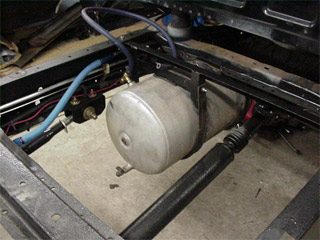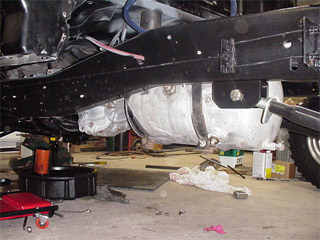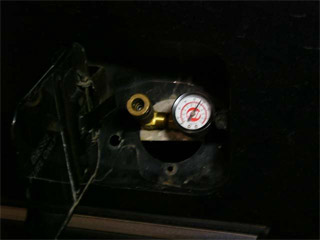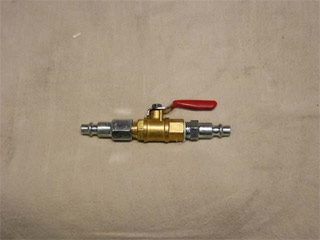It’s always handy to have compressed air with you for filling your flat tires, other people’s flat tires, air horns, blowing mulch or straw out of your bed, the list can go on and on. I use compressed air mainly for my air horns. I’ve had a 9 gallon air tank in my aluminum bed tool box since I put the horns on, and have always wanted to get rid of the tank to free up some more room in my tool box. I came across a Big Rig salvage yard and found a pair of aluminum air tanks. Below is how I mounted one of the tanks. I still do not have an on-board air source so the tank needs to be remotely filled and maintained.
Overview of Project:
Pretty simple to do, just some basic fabrication skills and some scrap steel are required. First, I received the tanks still mounted on the bracket that was bolted to the Big Rig frame. I unbolted one tank and stripped it down of all of it’s hoses and plugged all of the threaded holes with brass head plugs. I like using the external square head plugs because the internal ones seem to fill up with garbage and can round-out easily. Then, I found a place to mount the tank (where the front fuel tank was since I eliminated it when I installed a Bronco Fuel Tank), made a bracket to span the frame rails and used the existing straps to secure the tank to the framing. Once the tank was mounted I removed one of the plugs and plumbed two air lines to the tank with a tee. One line goes to the air horn button mounted on the dash, and the other goes to where the front filler neck used to be. There I have an air chuck and air gauge so I can easily fill the tank, know how much air is in it, and I can easily connect my air hose to it. Works really slick. But only if you sacrifice your front fuel tank!
Materials Used:
- Used Big Truck air tank, many sizes and prices.
- Misc. steel for fabricating the mounts to the frame of the truck.
- Misc. air hose and fittings to run air line from tank to front fuel door, where fuel tank filler used to be.
Total cost of project varies depending on the cost of your tank. My total was under $30 because I had most of what I needed lying around the shop.
Mounting the air tank:

This photo shows the steel angle bracket I made that spans the frame rails of the truck. I used the existing straps, one in front and one in back, to hold the tank tight to the frame. The blue air line mounted on the side of the tank leads to the air chuck and gauge at the front fuel door.

This is a photo of the bottom side of the tank. The tank came with a drain valve and several threaded ports. The red line is the supply for the air horns.

A photo of the air chuck and gauge. Only possible with out the front fuel tank, though.

This is the little gizmo I threw together to make filling up the tank quicker. I connect one end to the tank (make sure the valve is closed first!) and the other end to my shop compressor. Then I open the valve and the small tank is pressurized to whatever the shop tank is, around 100 psi to 120 psi. Very quick!
Results:
Works great! Tank is out of the way and I have a lot more room in my tool box now. Easy to fill the tank and easy to use. Now if I can just come up with a good, cheap 12v air compressor to keep the tank filled!
Happy Wrenching!

